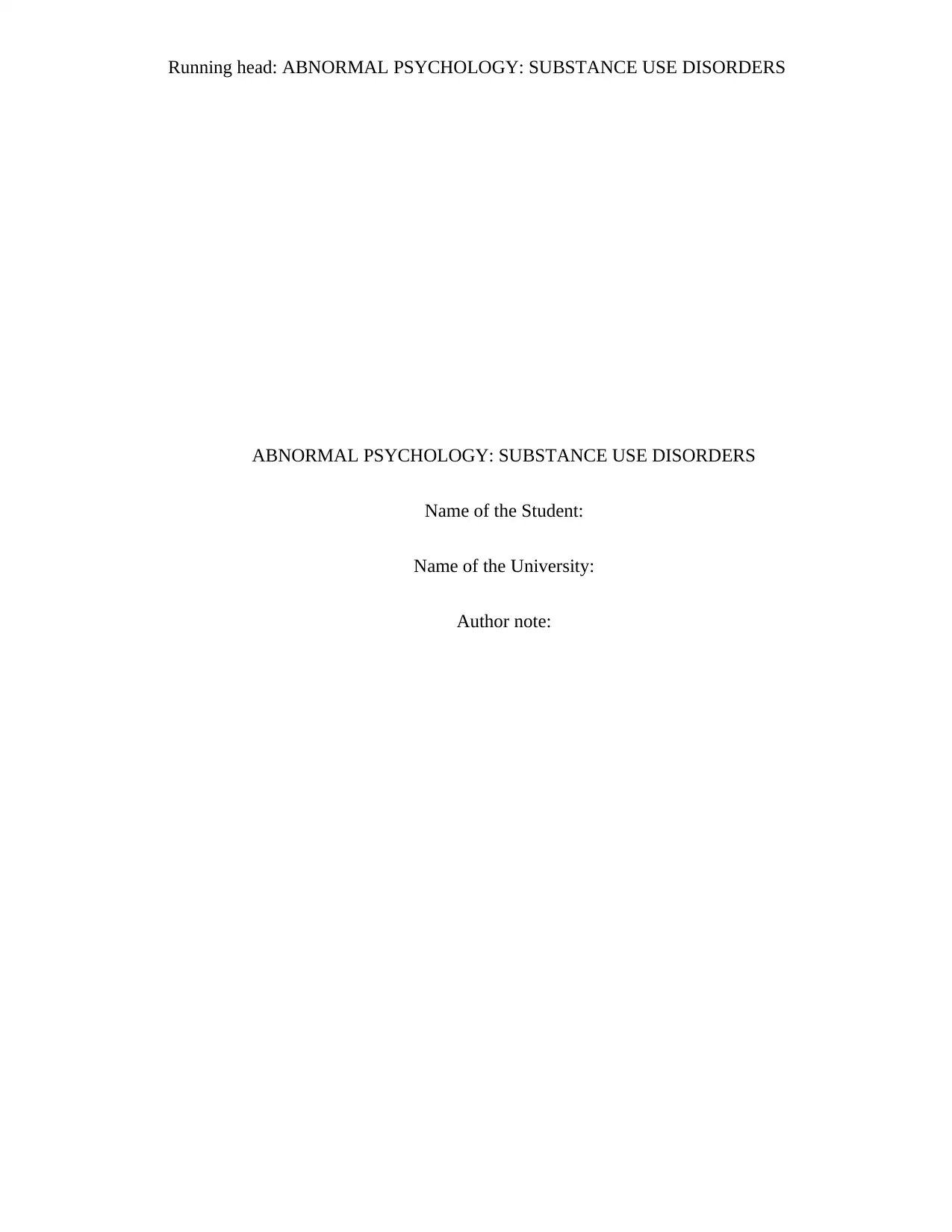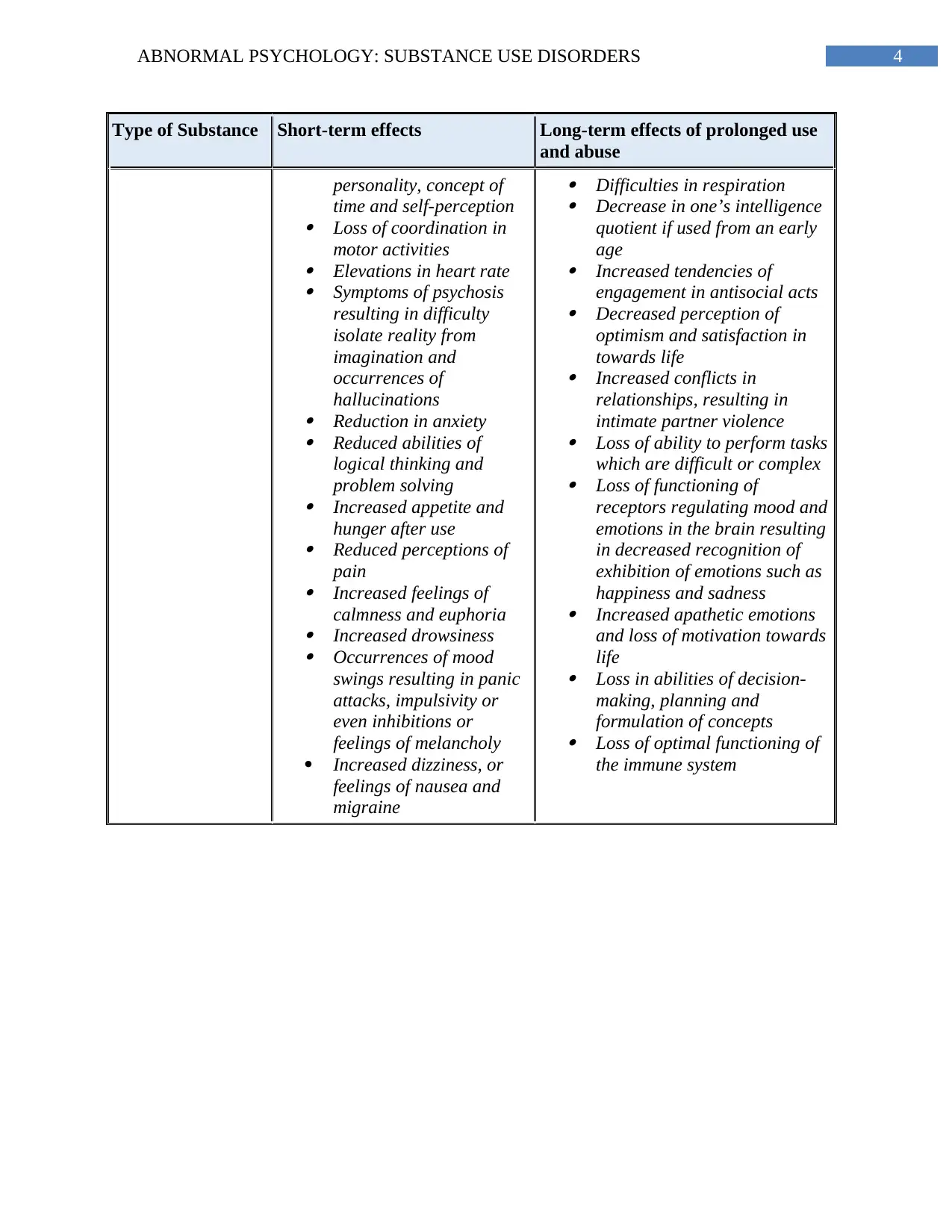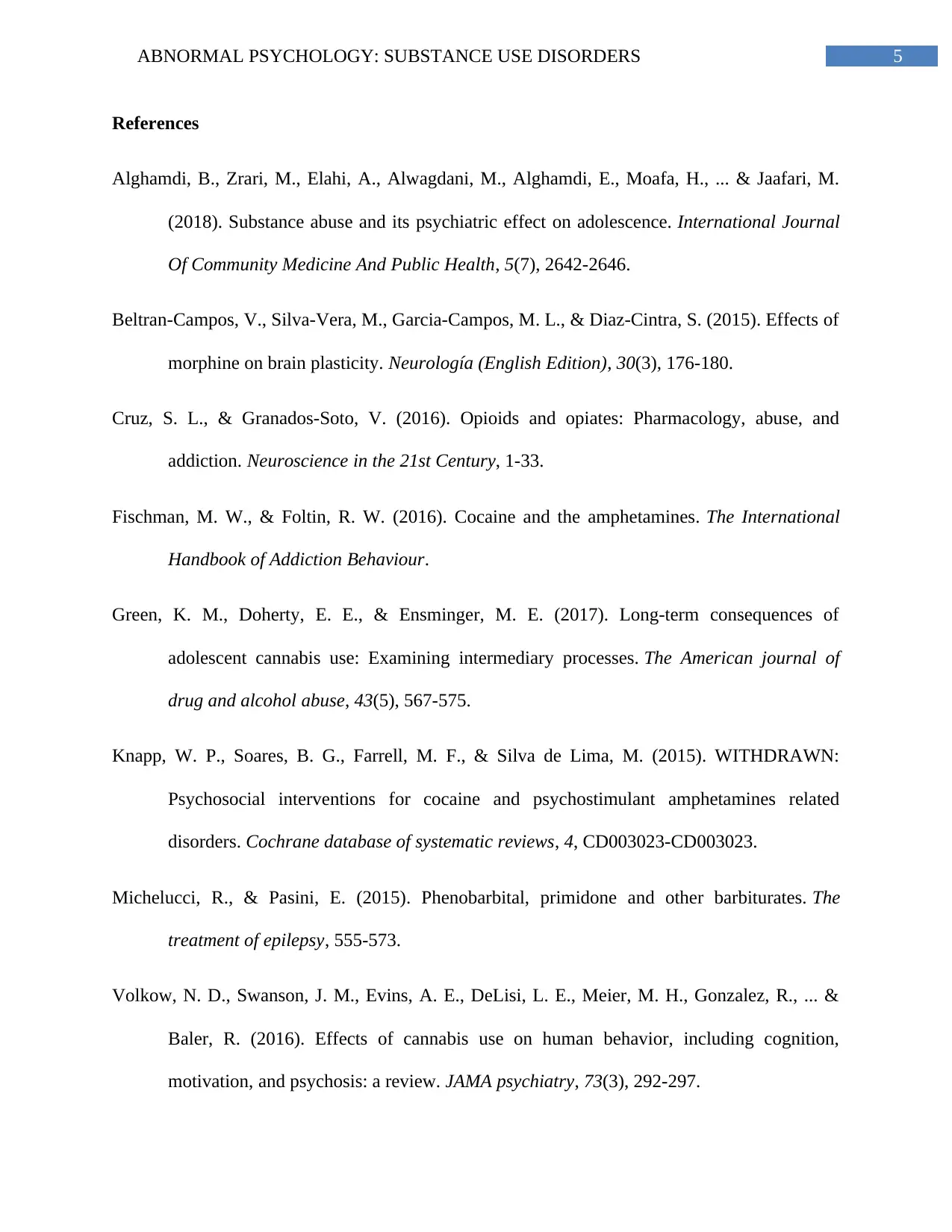Effects of Substance Use/Abuse/Dependence in Abnormal Psychology
VerifiedAdded on 2023/04/23
|7
|1462
|211
Homework Assignment
AI Summary
This assignment, focusing on abnormal psychology, examines the short and long-term effects of various substance use disorders. The document provides a detailed table outlining the impact of substances like barbiturates, benzodiazepines, opiates, amphetamines, and cannabis. It covers both the immediate and prolonged consequences, including physiological, psychological, and cognitive effects. The assignment considers the effects of these substances on the central nervous system, mental health, and overall well-being. The assignment also references relevant literature including research papers and studies to support the information. The document aims to provide a comprehensive overview of the multifaceted nature of substance use disorders, emphasizing the importance of understanding the range of effects associated with different substances.

Running head: ABNORMAL PSYCHOLOGY: SUBSTANCE USE DISORDERS
ABNORMAL PSYCHOLOGY: SUBSTANCE USE DISORDERS
Name of the Student:
Name of the University:
Author note:
ABNORMAL PSYCHOLOGY: SUBSTANCE USE DISORDERS
Name of the Student:
Name of the University:
Author note:
Paraphrase This Document
Need a fresh take? Get an instant paraphrase of this document with our AI Paraphraser

1ABNORMAL PSYCHOLOGY: SUBSTANCE USE DISORDERS
Short and Long-term Effects of Substance Use/Abuse/Dependence
Type of Substance Short-term effects Long-term effects of prolonged use
and abuse
Barbituates and
Benzodiazepines
i.e. tranquilizers,
hypnotics, sedative
(Nembutal, valium,
zanax, halcyon)
Short-term effects:
Relief from Anxiety
Relief from Insomnia and
sleeplessness
Increased feelings of
relaxation
Depression of the central
nervous system leading to
decreased inhibitions and
feelings of euphoria or
increased happiness
(Michelucci & Pasini,
2015).
Long-term effects
Unpleasant emotions of
irritability, anger and
annoyance upon withdrawal.
As noted by Walsh and Katz (2016),
additional long term effects include:
Increased levels of fatigue or
lethargy
Loss of consciousness in high
doses or prolonged use
resulting in damage to the
brain or organs and coma
Difficulties in breathing that
can develop into pneumonia or
bronchitis
Irregularities in the menstrual
cycle
Loss of memory for short even
longer time periods
Renal or hepatic diseases
Lack of controlled body
movements resulting in
twitching or uncoordinated
motor functions
Reductions in the span of
attention
Increased risk of
cardiovascular diseases
Sexual dysfunction
Gradual slowing of reflex
movements
Increased possibility of
developing a physical
dependency
Feelings of vomiting and
nausea
Gastrointestinal disorders
such as diarrhoea or
constipation
Short and Long-term Effects of Substance Use/Abuse/Dependence
Type of Substance Short-term effects Long-term effects of prolonged use
and abuse
Barbituates and
Benzodiazepines
i.e. tranquilizers,
hypnotics, sedative
(Nembutal, valium,
zanax, halcyon)
Short-term effects:
Relief from Anxiety
Relief from Insomnia and
sleeplessness
Increased feelings of
relaxation
Depression of the central
nervous system leading to
decreased inhibitions and
feelings of euphoria or
increased happiness
(Michelucci & Pasini,
2015).
Long-term effects
Unpleasant emotions of
irritability, anger and
annoyance upon withdrawal.
As noted by Walsh and Katz (2016),
additional long term effects include:
Increased levels of fatigue or
lethargy
Loss of consciousness in high
doses or prolonged use
resulting in damage to the
brain or organs and coma
Difficulties in breathing that
can develop into pneumonia or
bronchitis
Irregularities in the menstrual
cycle
Loss of memory for short even
longer time periods
Renal or hepatic diseases
Lack of controlled body
movements resulting in
twitching or uncoordinated
motor functions
Reductions in the span of
attention
Increased risk of
cardiovascular diseases
Sexual dysfunction
Gradual slowing of reflex
movements
Increased possibility of
developing a physical
dependency
Feelings of vomiting and
nausea
Gastrointestinal disorders
such as diarrhoea or
constipation

2ABNORMAL PSYCHOLOGY: SUBSTANCE USE DISORDERS
Type of Substance Short-term effects Long-term effects of prolonged use
and abuse
Blurring of vision
Vertigo and headache
Chronic usage can further result in
(Alghamdi et al., 2018):
Increased sweating,
palpitations and sensitivities to
pain and sound.
Suicidal thoughts and ideation
towards suicide
Slurring of speech or stupour
Opiates
i.e. heroin,
morphine, codeine
Short-term effects
Relief from pain
Feelings of Happiness
and Euphoria
Feelings of drowsiness
Sedative effects (Beltran-
Campos et al., 2015)
Long-term effects
As noted by Cruz and Granados-Soto
(2016), long term effects include:
Feelings of vomiting and
nausea
Gastrointestinal disturbances
such as bloating, constipation
and distension of the abdomen
Damage to the liver (increased
susceptibility in situations of
combined usage of opiates and
acetaminophen
Prolonged use may result in
reduced oxygen supply
resulting in hypoxia, depressed
respiratory functioning and
damage to the brain
Increased levels of tolerance
and dependence with
prolonged use
Increased feelings of paranoia
Amphetamine and
Cocaine
i.e.speed, ice, crack
Short-term Effects
Elevated levels of Arousal
Quick and sudden
elevations in energy
levels
As noted by Fischman and Foltin
(2016), short term effects
include:
Long-term Effects
Prolonged use may result in
Amphetamine psychosis –
which produces symptoms of
hallucination, mistrust and
paranoia similar to paranoid
schizophrenia
Increased levels of tolerance
resulting in feelings of
cravings towards the drugs
Type of Substance Short-term effects Long-term effects of prolonged use
and abuse
Blurring of vision
Vertigo and headache
Chronic usage can further result in
(Alghamdi et al., 2018):
Increased sweating,
palpitations and sensitivities to
pain and sound.
Suicidal thoughts and ideation
towards suicide
Slurring of speech or stupour
Opiates
i.e. heroin,
morphine, codeine
Short-term effects
Relief from pain
Feelings of Happiness
and Euphoria
Feelings of drowsiness
Sedative effects (Beltran-
Campos et al., 2015)
Long-term effects
As noted by Cruz and Granados-Soto
(2016), long term effects include:
Feelings of vomiting and
nausea
Gastrointestinal disturbances
such as bloating, constipation
and distension of the abdomen
Damage to the liver (increased
susceptibility in situations of
combined usage of opiates and
acetaminophen
Prolonged use may result in
reduced oxygen supply
resulting in hypoxia, depressed
respiratory functioning and
damage to the brain
Increased levels of tolerance
and dependence with
prolonged use
Increased feelings of paranoia
Amphetamine and
Cocaine
i.e.speed, ice, crack
Short-term Effects
Elevated levels of Arousal
Quick and sudden
elevations in energy
levels
As noted by Fischman and Foltin
(2016), short term effects
include:
Long-term Effects
Prolonged use may result in
Amphetamine psychosis –
which produces symptoms of
hallucination, mistrust and
paranoia similar to paranoid
schizophrenia
Increased levels of tolerance
resulting in feelings of
cravings towards the drugs
⊘ This is a preview!⊘
Do you want full access?
Subscribe today to unlock all pages.

Trusted by 1+ million students worldwide

3ABNORMAL PSYCHOLOGY: SUBSTANCE USE DISORDERS
Type of Substance Short-term effects Long-term effects of prolonged use
and abuse
Quickening of reaction
times
Feelings of high elevated
levels of wakefulness
Increased feelings of
excitement, excessive
happiness and euphoria
Elevated levels of
concentration and
attention
Drying of mouth,
headaches, giddiness,
nausea and loss of
appetite
Increased feelings of
anxiety and hostility
Increase in body
temperature and blood
pressure resulting in
hypertension
Impaired cognitive
functions
Increased rate of
breathing, palpitations
and heartbeat
Constriction of blood
vessels
Disturbances in sleep
Dilation of pupils
As noted by Knapp et al., (2015), long
term effects include:
Increased conductance of
behaviours which are violent
Difficulties in breathing and
respiration
Frequent states of
hallucinations
Increased drug-usage
behaviours which are
compulsive
Increase conductance of
obsessive behaviours
Lack of coordination in motor
movements
Frequent occurrences of
convulsions
Irreversible damage to the
blood vessels of the brain and
heart
Damage to tissues in the nose
Loss of weight and
malnutrition
Severe symptom of depression
Decaying of the teeth and
damage to the oral cavity
Prolonged use can lead to
hypertension and
cardiovascular diseases such
as stroke and myocardial
infarction
Cannabis
i.e. marijuana,
hashish
Short-term Effects
As noted by Volkow et al.,
(2016), short term effects
include:
Slowing down of reaction
time
Loss of short term
memory
Feelings of mistrust and
paranoia
Losing one’s sense of
Long-term Effects
Long term use may rarely
result in withdrawal and
tolerance
As noted by Green, K. M., Doherty, E.
E., & Ensminger, M. E. (2017), long
term effects include:
Severe losses in cognitive
abilities of learning and
thinking
Type of Substance Short-term effects Long-term effects of prolonged use
and abuse
Quickening of reaction
times
Feelings of high elevated
levels of wakefulness
Increased feelings of
excitement, excessive
happiness and euphoria
Elevated levels of
concentration and
attention
Drying of mouth,
headaches, giddiness,
nausea and loss of
appetite
Increased feelings of
anxiety and hostility
Increase in body
temperature and blood
pressure resulting in
hypertension
Impaired cognitive
functions
Increased rate of
breathing, palpitations
and heartbeat
Constriction of blood
vessels
Disturbances in sleep
Dilation of pupils
As noted by Knapp et al., (2015), long
term effects include:
Increased conductance of
behaviours which are violent
Difficulties in breathing and
respiration
Frequent states of
hallucinations
Increased drug-usage
behaviours which are
compulsive
Increase conductance of
obsessive behaviours
Lack of coordination in motor
movements
Frequent occurrences of
convulsions
Irreversible damage to the
blood vessels of the brain and
heart
Damage to tissues in the nose
Loss of weight and
malnutrition
Severe symptom of depression
Decaying of the teeth and
damage to the oral cavity
Prolonged use can lead to
hypertension and
cardiovascular diseases such
as stroke and myocardial
infarction
Cannabis
i.e. marijuana,
hashish
Short-term Effects
As noted by Volkow et al.,
(2016), short term effects
include:
Slowing down of reaction
time
Loss of short term
memory
Feelings of mistrust and
paranoia
Losing one’s sense of
Long-term Effects
Long term use may rarely
result in withdrawal and
tolerance
As noted by Green, K. M., Doherty, E.
E., & Ensminger, M. E. (2017), long
term effects include:
Severe losses in cognitive
abilities of learning and
thinking
Paraphrase This Document
Need a fresh take? Get an instant paraphrase of this document with our AI Paraphraser

4ABNORMAL PSYCHOLOGY: SUBSTANCE USE DISORDERS
Type of Substance Short-term effects Long-term effects of prolonged use
and abuse
personality, concept of
time and self-perception
Loss of coordination in
motor activities
Elevations in heart rate
Symptoms of psychosis
resulting in difficulty
isolate reality from
imagination and
occurrences of
hallucinations
Reduction in anxiety
Reduced abilities of
logical thinking and
problem solving
Increased appetite and
hunger after use
Reduced perceptions of
pain
Increased feelings of
calmness and euphoria
Increased drowsiness
Occurrences of mood
swings resulting in panic
attacks, impulsivity or
even inhibitions or
feelings of melancholy
Increased dizziness, or
feelings of nausea and
migraine
Difficulties in respiration
Decrease in one’s intelligence
quotient if used from an early
age
Increased tendencies of
engagement in antisocial acts
Decreased perception of
optimism and satisfaction in
towards life
Increased conflicts in
relationships, resulting in
intimate partner violence
Loss of ability to perform tasks
which are difficult or complex
Loss of functioning of
receptors regulating mood and
emotions in the brain resulting
in decreased recognition of
exhibition of emotions such as
happiness and sadness
Increased apathetic emotions
and loss of motivation towards
life
Loss in abilities of decision-
making, planning and
formulation of concepts
Loss of optimal functioning of
the immune system
Type of Substance Short-term effects Long-term effects of prolonged use
and abuse
personality, concept of
time and self-perception
Loss of coordination in
motor activities
Elevations in heart rate
Symptoms of psychosis
resulting in difficulty
isolate reality from
imagination and
occurrences of
hallucinations
Reduction in anxiety
Reduced abilities of
logical thinking and
problem solving
Increased appetite and
hunger after use
Reduced perceptions of
pain
Increased feelings of
calmness and euphoria
Increased drowsiness
Occurrences of mood
swings resulting in panic
attacks, impulsivity or
even inhibitions or
feelings of melancholy
Increased dizziness, or
feelings of nausea and
migraine
Difficulties in respiration
Decrease in one’s intelligence
quotient if used from an early
age
Increased tendencies of
engagement in antisocial acts
Decreased perception of
optimism and satisfaction in
towards life
Increased conflicts in
relationships, resulting in
intimate partner violence
Loss of ability to perform tasks
which are difficult or complex
Loss of functioning of
receptors regulating mood and
emotions in the brain resulting
in decreased recognition of
exhibition of emotions such as
happiness and sadness
Increased apathetic emotions
and loss of motivation towards
life
Loss in abilities of decision-
making, planning and
formulation of concepts
Loss of optimal functioning of
the immune system

5ABNORMAL PSYCHOLOGY: SUBSTANCE USE DISORDERS
References
Alghamdi, B., Zrari, M., Elahi, A., Alwagdani, M., Alghamdi, E., Moafa, H., ... & Jaafari, M.
(2018). Substance abuse and its psychiatric effect on adolescence. International Journal
Of Community Medicine And Public Health, 5(7), 2642-2646.
Beltran-Campos, V., Silva-Vera, M., Garcia-Campos, M. L., & Diaz-Cintra, S. (2015). Effects of
morphine on brain plasticity. Neurología (English Edition), 30(3), 176-180.
Cruz, S. L., & Granados-Soto, V. (2016). Opioids and opiates: Pharmacology, abuse, and
addiction. Neuroscience in the 21st Century, 1-33.
Fischman, M. W., & Foltin, R. W. (2016). Cocaine and the amphetamines. The International
Handbook of Addiction Behaviour.
Green, K. M., Doherty, E. E., & Ensminger, M. E. (2017). Long-term consequences of
adolescent cannabis use: Examining intermediary processes. The American journal of
drug and alcohol abuse, 43(5), 567-575.
Knapp, W. P., Soares, B. G., Farrell, M. F., & Silva de Lima, M. (2015). WITHDRAWN:
Psychosocial interventions for cocaine and psychostimulant amphetamines related
disorders. Cochrane database of systematic reviews, 4, CD003023-CD003023.
Michelucci, R., & Pasini, E. (2015). Phenobarbital, primidone and other barbiturates. The
treatment of epilepsy, 555-573.
Volkow, N. D., Swanson, J. M., Evins, A. E., DeLisi, L. E., Meier, M. H., Gonzalez, R., ... &
Baler, R. (2016). Effects of cannabis use on human behavior, including cognition,
motivation, and psychosis: a review. JAMA psychiatry, 73(3), 292-297.
References
Alghamdi, B., Zrari, M., Elahi, A., Alwagdani, M., Alghamdi, E., Moafa, H., ... & Jaafari, M.
(2018). Substance abuse and its psychiatric effect on adolescence. International Journal
Of Community Medicine And Public Health, 5(7), 2642-2646.
Beltran-Campos, V., Silva-Vera, M., Garcia-Campos, M. L., & Diaz-Cintra, S. (2015). Effects of
morphine on brain plasticity. Neurología (English Edition), 30(3), 176-180.
Cruz, S. L., & Granados-Soto, V. (2016). Opioids and opiates: Pharmacology, abuse, and
addiction. Neuroscience in the 21st Century, 1-33.
Fischman, M. W., & Foltin, R. W. (2016). Cocaine and the amphetamines. The International
Handbook of Addiction Behaviour.
Green, K. M., Doherty, E. E., & Ensminger, M. E. (2017). Long-term consequences of
adolescent cannabis use: Examining intermediary processes. The American journal of
drug and alcohol abuse, 43(5), 567-575.
Knapp, W. P., Soares, B. G., Farrell, M. F., & Silva de Lima, M. (2015). WITHDRAWN:
Psychosocial interventions for cocaine and psychostimulant amphetamines related
disorders. Cochrane database of systematic reviews, 4, CD003023-CD003023.
Michelucci, R., & Pasini, E. (2015). Phenobarbital, primidone and other barbiturates. The
treatment of epilepsy, 555-573.
Volkow, N. D., Swanson, J. M., Evins, A. E., DeLisi, L. E., Meier, M. H., Gonzalez, R., ... &
Baler, R. (2016). Effects of cannabis use on human behavior, including cognition,
motivation, and psychosis: a review. JAMA psychiatry, 73(3), 292-297.
⊘ This is a preview!⊘
Do you want full access?
Subscribe today to unlock all pages.

Trusted by 1+ million students worldwide

6ABNORMAL PSYCHOLOGY: SUBSTANCE USE DISORDERS
Walsh, S. J., & Katz, K. D. (2016). Barbiturates. Critical Care Toxicology, 1-10.
Walsh, S. J., & Katz, K. D. (2016). Barbiturates. Critical Care Toxicology, 1-10.
1 out of 7
Related Documents
Your All-in-One AI-Powered Toolkit for Academic Success.
+13062052269
info@desklib.com
Available 24*7 on WhatsApp / Email
![[object Object]](/_next/static/media/star-bottom.7253800d.svg)
Unlock your academic potential
Copyright © 2020–2025 A2Z Services. All Rights Reserved. Developed and managed by ZUCOL.





